If you delight in the serenity of historical temples and beautiful, ornate Japanese gardens with lavish ponds and trailing temples and gardens scattered around a city of around 320 square miles, it can be difficult to decide what to do in Kyoto. If you are short on time and want to know what you must see in Kyoto in 2 days, follow our Kyoto 2 day itinerary. You will visit delightful gardens, sublime temples, mountainside shrines and the mysterious Geisha District. Our Kyoto 2 day itinerary aims to take the pain out of planning your trip and give you an intoxicating introduction to this fascinating city.
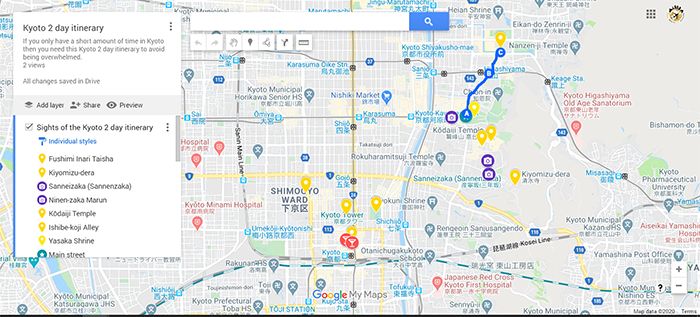
By the way, you can download this itinerary on GPSMYCITY.
Plan your Kyoto 2 day itinerary
Before you start this Kyoto 2 day itinerary, there are a couple of must-haves for your trip. First, head to the tourist information on the 2nd floor of the train station. Steps lead up from the bus terminal with escalators on either side. Take these and head straight ahead at the top. The tourist information is on the right-hand side, less than 100 yards from the top of the stairs.
At the desk, ask for a map of the bus and subway and a city map. These two documents will be a godsend (shown below). The green transport map provides colour coded details of the bus routes.
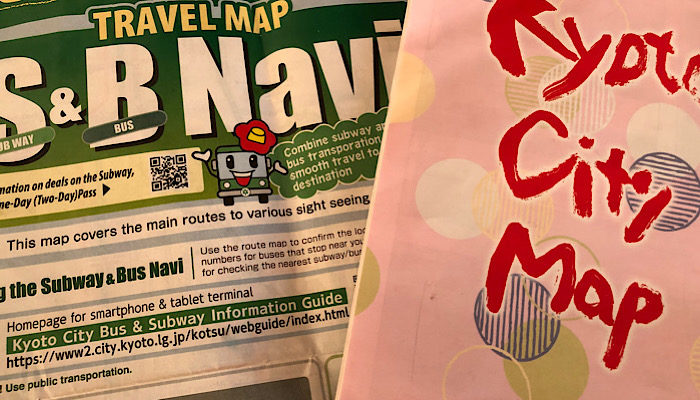
It also includes a useful grid which highlights details of the nearest bus stop or station for some of the key attractions. I have reproduced this below and although the quality isn’t good, you can see that the destinations are along the top and the start points on the left. The grid then highlights the bus you need to connect the two points. Genius!!

The city map is much more detailed than anything your hotel will provide and highlights some of the key areas for sights.
Day one of the 2 days in Kyoto itinerary
Eastern suburbs
Once you are armed with your survival maps, head to Fushimi-Inari Taisha Shrine for a delightful hike.
Fushimi-Inari Taisha Shrine
Getting to Fushimi-Inari Taisha
To get there, take a train on line D from platform 8, 9 or 10. Make sure the train is going to Joyo and jump off at the second stop, Inari. The train drops off directly opposite the entrance to the temple and you will spot the bright orange arch when you exit.
You can also take the Keihan train from the central station. The Keihan station is a little further from the entrance to the temple. When you exit, turn left, then at the intersection turn right and walk a few hundred metres. The shrine will be on your left.

Exploring Fushimi-Inari Taisha Shrine
At the bottom of the trail, there are a number of temples which practically glow in the sun. They sit alongside traditional teahouses and souvenir stands selling magnets, scrolls and other mementoes. If you head up the stairs, and over to the right, you will see the entrance to the gated walkway.
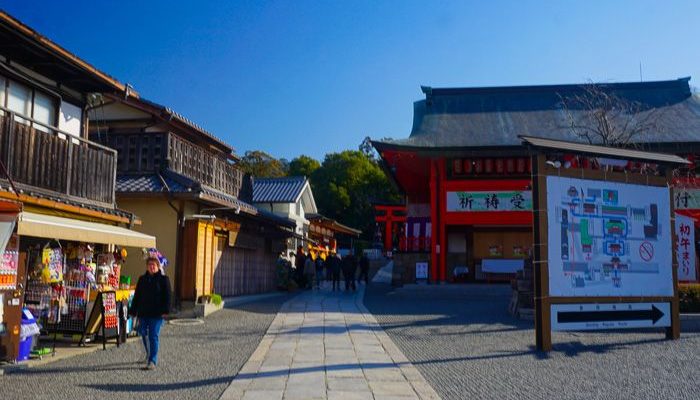
Fushimi Inari Torii Gates
Over 5,000 vivid orange torii gates line a stone pathway as it weaves around the mountainside to a shrine on the top at 233 metres. Although the path will be bustling with tour groups near the bottom, as you continue upwards the numbers will thin out. You should even be able to enjoy some moments of solitude to drink in the stunning surroundings. For over 4km the path meanders through the woods, a bright intrusion amongst the bamboo and foliage.
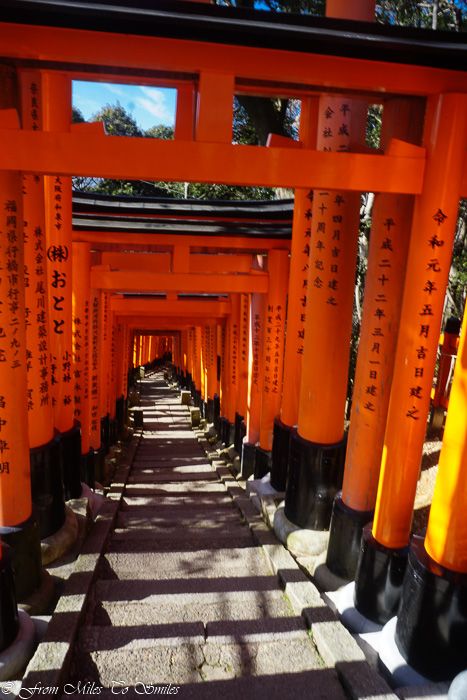
It truly feels like you are climbing the stairway to heaven. As you walk, sunbeams dance between the gates and illuminate the walkway. Although I’d seen many pictures of this stunning shrine before our visit, the reality far surpassed my expectations. It is a must-see on your Kyoto 2 day itinerary.
Entry: free.
Kiyomizu-dera
From Fushimi-Inari, take the Keihan train to Gojozaka and then walk north to Kiyomizu-dera. This temple perches on a hillside above an emerald lake with views of the city. As you wander around the base of the temples, you will be as fascinated by the people watching as you will be by the architecture and detailed sculptures. Young girls, resplendent in vividly coloured kimonos, pose seductively for photos. They giggle excitedly as they aim to capture the perfect picture.
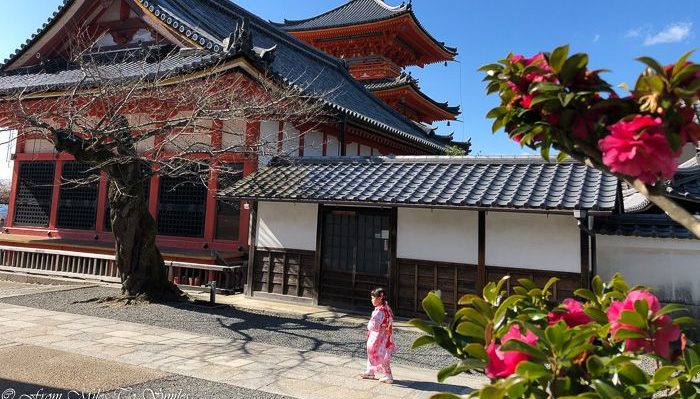
Entry: It’s free to wander the base of the bright orange temples. However, the shrines to the rear charge an entry fee of ¥400.
Sannenzaka and Ninenzaka streets
From Kiyomizu-dera, follow the cobbled pedestrian road of Sannenzaka towards Kodai-ji. It is a delightful street, brimming with quaint tourist shops. Scents of incense drift on the breeze and girls in brightly coloured kimonos stroll the narrow lane often feasting on green matcha flavoured ice cream. Keep your eyes peeled for a narrow lane off to the right called Ninenzaka. It is another hauntingly beautiful sight which leads directly to the Kodai-ji temple.
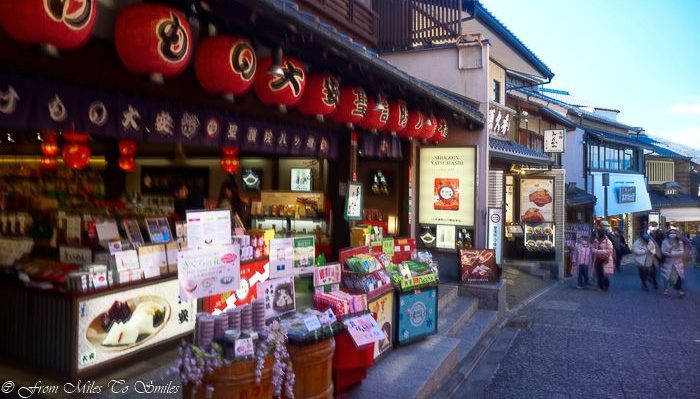
As you descend Ninenzaka, take your time to browse the pretty shops laden with silk kimonos, decorative Japanese writing, and sweet-smelling incense.
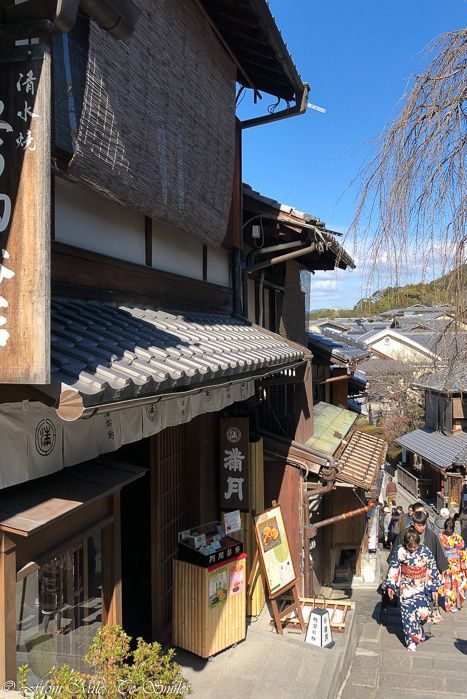
Kodai-ji temple
There are two temples on the same complex, so to reach Kodai -ji temple, take the steps opposite the entrance to Ninenzaka. Head past the coffee shop and across the square. You will catch glimpses of a huge Buddha towering above the garden in the Ryozen Kannon complex but continue past.
As you enter Kodai-ji temple, picturesque lanterns adorn a charming building by the entrance. You can also admire the stand crammed full of wooden plaques decorated with ‘wishes’ written in ornate script.

The main attraction is, however, the zen garden of Kodai-ji, a romantic garden dedicated to the late husband of a grieving noblewoman. The garden is a testament to her love, with its beautiful design linking ponds, pavilions, shrines and teahouses. A particularly lovely section of the garden is the bamboo grove which weaves through the trees above the adjacent Ryozen Kannon temple. From there, you can also catch fleeting glimpses of the huge Buddha next door.
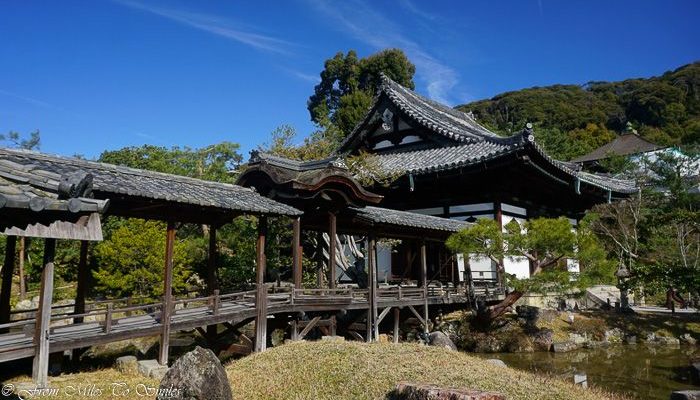
Entry: ¥600
Moving on from Kodai-ji temple
Once you have feasted on the glorious garden scenes, exit the site down a long sloping staircase and turn right onto a narrow cobbled street. As you amble along Ishibe-koji Alley, you will spot simple ryokan and tiny Inari temples with distinctive miniature torii gates. Before long, you will reach the Yasaka Shrine, another Inari temple which has occupied this site for over 1350 years. Previously known as Gion Shrine, its name was changed to disassociate from the allegedly ‘wayward’ ways of the Geisha from the Gion district.
Yasaka Shrine
Yasaka Shrine is famous for the summer festival of Gion Matsuri which takes place every July. The festival dates over a thousand years and the highlight is a procession with huge floats. Another popular time to visit Yasaka Shrine is in spring when the cherry blossom bursts into flower.
If you exit the main entrance of Yasaka Shrine, you will find yourself in Gion. This is one of the several Geisha district around the city.
Entry: ¥0
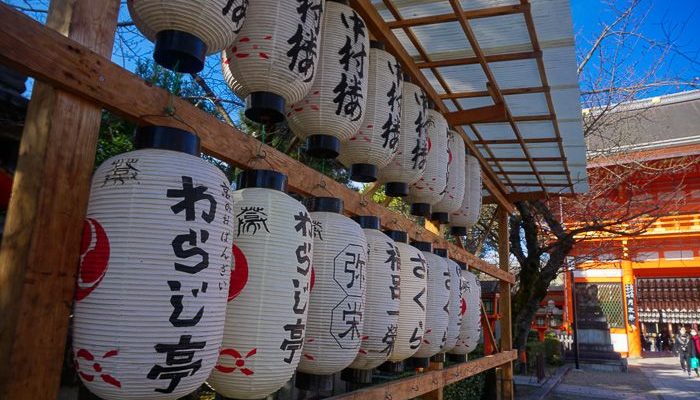
Lunchtime
Gion
By this time, it is likely you have built up an appetite and Gion is a great place to stop for a bite to eat. Note, many restaurants and bars are on higher floors, so you will need to keep your eyes peeled. If you face down the road opposite the shrine exit, the more reasonably priced venues are to the right of the Main Street.
On the map below, they are shown on the top half of the picture.
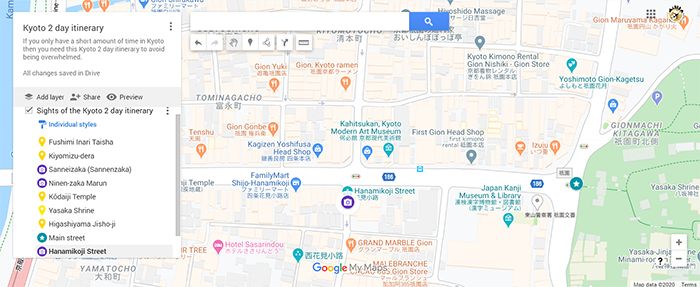
To the left, however, is the mysterious and hauntingly beautiful historic district of the Geisha. Shrouded in mystique, the centuries-old tradition of Geisha lives on but in significantly dwindling numbers.
This area has restrictions on photography and anyone without a permit can be fined ¥10,000 (around £70).
Entry: ¥0
Geisha district – Hanamikoji Street
Hanamikoji Street is hauntingly beautiful with bright red lanterns fluttering outside faded wooden doorways. On first sight, it looks abandoned and derelict, yet this area is jam-packed with discrete teahouses. These wooden buildings have no signs to identify them as they only host high-end guests in the know. Hidden behind wooden latticed doorways, guests eat and drink whilst playing games. Geishas and Maikos (trainee Geisha) are the star attraction as they entertain guests with traditional Japanese arts, music and dancing.
Visitors need to reserve months in advance as priority is given to regular guests. Indeed it is taboo for locals to frequent different teahouses as it is customary to remain loyal to one teahouse. You can see why there is no need for signage.
Geisha culture
The world of the Geisha is an intriguing aspect to Japanese culture and one which is difficult to understand for Westerners. The teahouses seem more like a secret club that only the privileged can enter.
However contrary to common misconceptions Geishas are not prostitutes but talented entertainers. As teenagers, they interview at one of the boarding houses in this district. If they are successful, they will study for five years to become a fully-fledged Geisha.
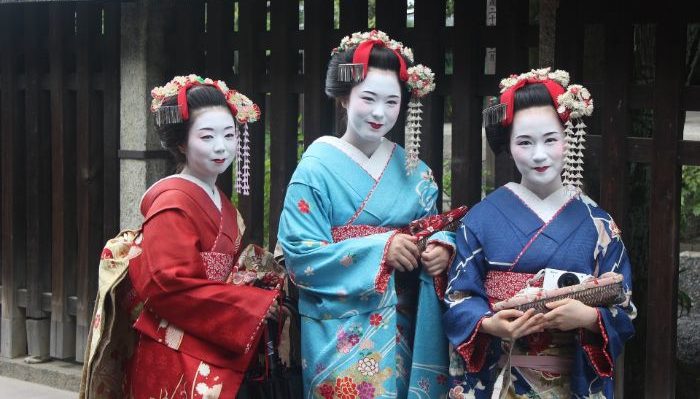
To learn more about the fascinating stories and tutelage of the Geisha, I highly recommend an evening walking tour. We booked through Get Your Guide and the mobile voucher downloads to the app once you book. You simply need to show the voucher to the guide when you arrive. The tour cost just £9.40 and was worth every penny.
Afternoon of day one
Once you feel suitably refreshed, continue walking north (see the walking section highlighted on the Kyoto 2 day itinerary Google map below). Follow the little canal which veers off sharply to the right. This is a delightful place to stroll with weeping willows lining the canal. As you walk, you can admire beautifully preserved ryokan nestled between more modern apartments.
The canal exits by an orange Inari archway which signals the entrance to the Heian Jingu Shrine.

Heian Jingu Shrine
The Heian Jingu Shrine is another free temple and garden with a huge courtyard and large prayer halls built from wood painted in vivid orange.
There are a couple of museums around the shrine which is in spacious grounds around a central court. The main buildings are a partial replica of the original Imperial Palace.
From here either walk northeast towards Ginkakuji temple or take bus 100.
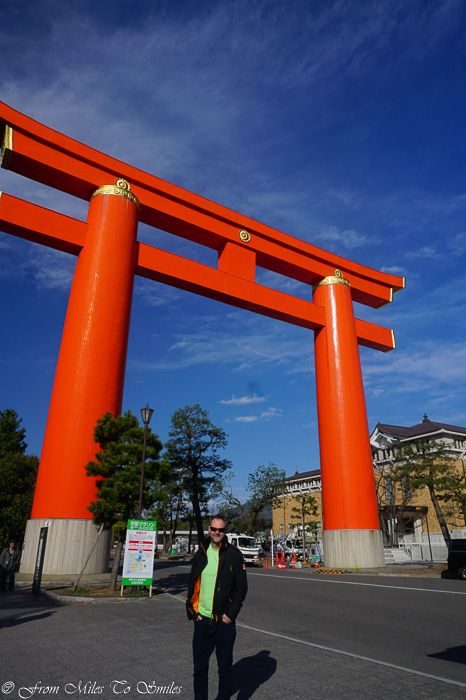
Ginkakuji Temple (silver pavilion)
Ginkakuji temple is a UNESCO world heritage site set in stunning gardens which blend harmoniously into the surrounding mountainside. Whilst the silver pavilion is far from silver, the winding pathway which passes temple halls, a pavilion and miniature shrines is nevertheless a shining example of Kyoto architecture.
Entry: ¥600
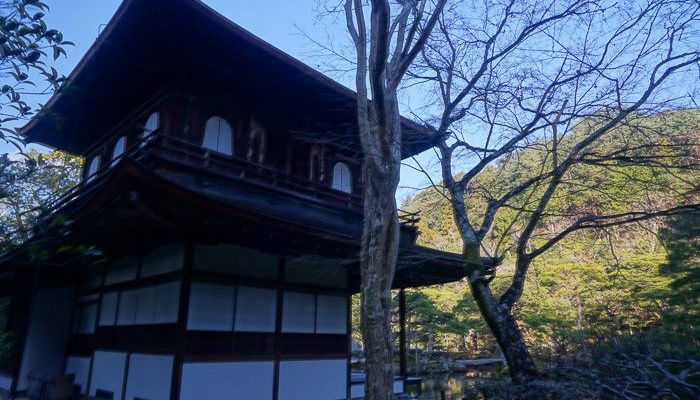
By now, you will likely have walked some distance and may be ready for a rest before the evening entertainment. The Geisha tour is not to be missed.
Evening walking tour
As mentioned previously, I highly recommend that you book your walking tour with Get Your Guide. It costs just £9.40 per person and provides tons of insight into the life of a Geisha. Contrary to the glamorous perception of Geisha life, you will soon discover that the reality is much more mundane. Geishas work long days with multiple appointments and strict restrictions on their activities. For instance, marriage puts an end to a Geisha’s career.
Gion by night
As you stroll along the worn cobbles of Gion in the evening, you may catch an occasional glimpse of an alluring Geisha flitting between evening appointments. More likely however is that you will question whether you are in the wrong place. Restaurants and bars hide behind closed doors shrouded in darkness. The only indication that the establishments are open is cotton drapes in shades of red, purple and blue which stream from doorways. Hushed whispers and occasional laughter carry on the breeze, and you may catch a scent of musky incense.
Eating and dining in this area is upmarket with set dinners costing anything up to ¥20,000 a person (around £140).
Day 2 – morning
Arashiyama bamboo forest
Rise early and take bus 28 to Arashiyama. This is a quaint suburb of Kyoto and the main street is lined with pretty stores selling endless sweets and chocolates.
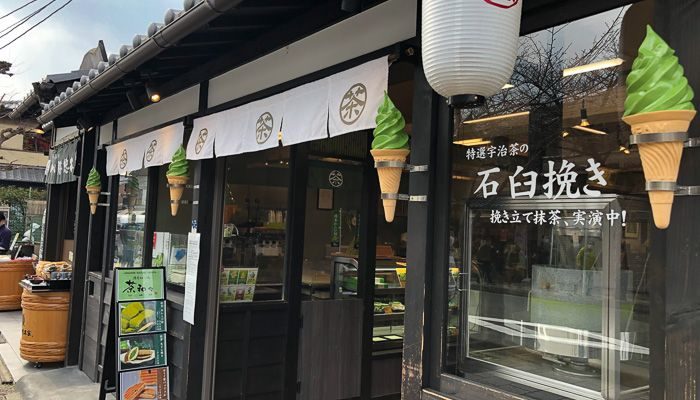
Pass the station on your right and a little further along to the left is a narrow alley leading to the Arashiyama bamboo forest. This alley leads through towering trees of bamboo which cast kaleidoscopic shadows on the pathway below. It’s a serene place, even with crowds of tourists, and a welcome respite from the hustle of the city.
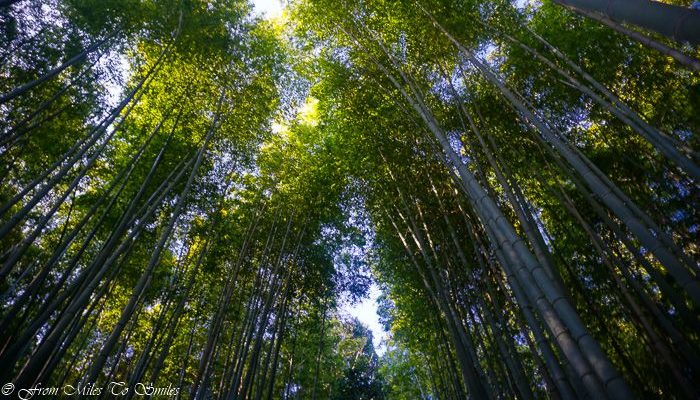
Entry: ¥0
Tenryu-ji temple
From the bamboo forest, head back towards the Main Street (shown as route 29 on our Kyoto 2 day itinerary map). Stop to explore the exquisite gardens of the Tenryu-ji temple. The landscaped garden behind the main prayer hall is one of the most ancient in Japan and retains the original design from the 14th century. It offers a scenic stroll through stunning gardens with ornamental ponds and cherry blossoms.
Entry: ¥500
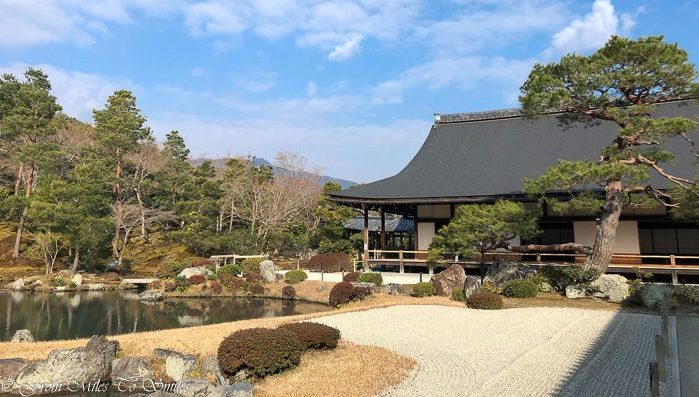
Once you’ve finished admiring the temples and gardens, exit by the garden entrance and walk to route 29 to catch a bus to your next stop. Bus 11 will take you towards Kinkaku-ji temple. You will need to change to bus 59 at the terminus of bus 11.

Kinkaku-ji temple (The Golden Pavilion)
The Kinkaku-ji temple is an ornate affair which floats serenely above a small ornamental pond. Gold foil covers the upper two levels and the pavilion casts stunning reflections in the lake.
The gardens are said to represent the pure land of Buddha and you can catch many stunning views of the pavilion as you wander the pathways. By contrast, the very simple Sekka-Tei Tea house is a plain but charming building perched on the top of the hillside.
From Kinkaku-ji temple, head to the Main Street around a hundred metres south of the exit. Jump on bus 205 or 101 to the train station.
Entry: ¥400

Lunchtime
For lunch, head into the food dining court beneath the station for reasonable set menus. I also highly recommend Soup Stock which does an incredible onion soup. Once you’ve eaten your fill, lace up your walking boots for the last few sights in and around the station.
Day two afternoon – downtown
Shosei-en garden
Of all the gardens we visited, the Buddhist temple of Shosei-en was my absolute favourite. Even in the cold grey of a Kyoto winter day, wandering the pathways of this garden was utterly captivating, an oasis in the heart of the city. It’s not difficult to understand why this garden holds the designation of a Japanese national scenic spot!
The delightful gardens of the Shosei-en explode into vivid orange, yellows and browns in autumn before shedding their foliage and entering the stark winter period. Buried under mounds of snow, the exquisite bridges and temples are however equally enthralling in winter. As the snows start to melt and balmier spring days envelop the city, the garden bursts into colour once again. Cherry blossom blooms alongside camellia and other flowers in shades of pink and white. The heady mix of colourful maple trees, wisteria, and fragrant plums is a real showstopper.
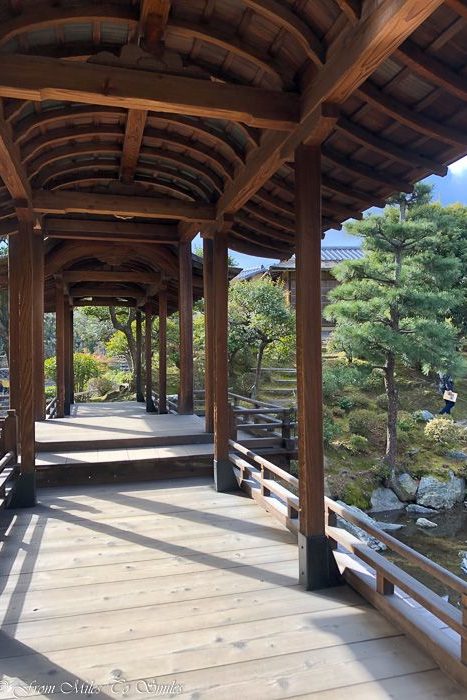
Curved ornamental bridges traverse the lake, and high rise buildings reflect in the water’s surface. The Kaito-ro bridge is the magnificent star of the show. Its fairytale wooden walkway joins the meandering pathway between teahouses and small shrines and is a great spot for photos.
Entry: ¥500
Higashi Honganji Temple
The Higashi Honganji Temple is dramatically different in design from the Inari temples. Huge wooden prayer halls have decorative eaves in white paint but otherwise, the décor is simple woodwork. This temple and Nishi Honganji, although in the centre of downtown, offer an oasis of calm and serenity for weary tourists needing to escape the crowds.
Best of all, both temples are free!
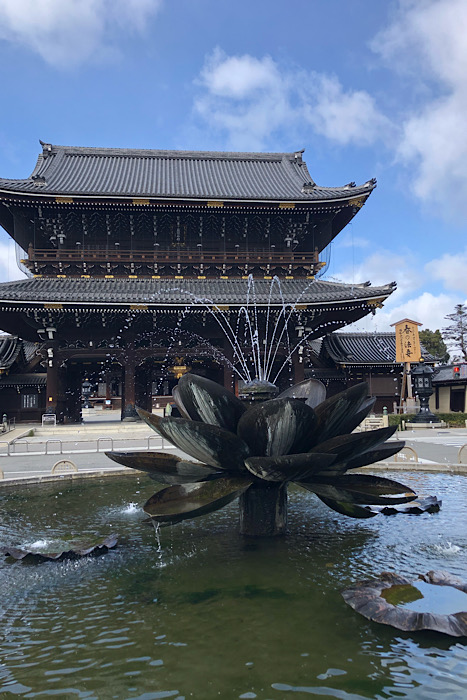
Entry: ¥0
Nishi Honganji Temple
The Nishi Honganji Temple follows much the same design and layout of Higashi Hongwanji Temple but is still worthy of a visit!!!
The Amidado (hall of Amira Buddha) was constructed in 1760 and is one of the largest wooden buildings in Japan.
Entry: ¥0
Kyoto tower
Lonely Planet is quite disparaging about a trip up Kyoto tower but given the modest price, I would urge you to make the ascent. The observation deck at the top gives you far-reaching views over the city to snow-capped peaks beyond. You can also spot the many temples that you have visited during your 2 days in Kyoto.
The tower has interactive displays in English and Japanese to highlight the sights around the city. The last entry is at 21.00 but you could time your arrival for dusk to capture scenes by day and night.
Entry: ¥800
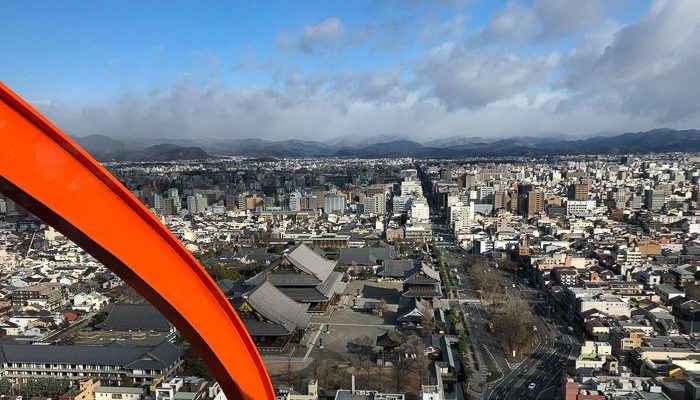
This Kyoto 2 day itinerary is a great introduction to the major sights of the city but what else does a first-timer to the city need to know?
Useful information for your 2 days in Kyoto
Getting to Kyoto for your two day Kyoto itinerary
Check out flight options on Skyscanner. We flew with British Airways in Club class and paid little more than you would for economy class. That’s because we have worked out tons of ways to earn AVIOS without leaving the ground. If you want to learn more, check out the A-Z of AVIOS or drop me a line with any questions.

Getting from Kansai airport to Kyoto
If you fly into Osaka, there is a direct train on the JR Haruka Express from the international airport of Kansai direct to Kyoto station. We paid ¥2,400 each at the airport and this included a day subway pass valid for 24 hours in Kyoto. It also included a ticket for use on the Keihan line which we used to travel between Fushimi Inari and Kiyomizu-dera.
Note this ticket is only available to foreign visitors and you need to show your passport to qualify for this fare.
Interestingly, I booked our return ticket to the airport on Klook and two singles cost just $29.82 which converted into £23.72. I have just done a search from the UK for tickets and the price is lower still at £11.39 each.
Book JR Haruka Express Tickets

Getting around on the Kyoto 2 day itinerary
Although our train ticket from Osaka airport included a day subway pass, forget the subway. Trains rarely seem to go to the tourist attractions directly whilst the buses do.
Bus tickets cost ¥230 (less than £2 each). You board at the rear and exit at the front where you will pay the driver. The machine only accepts exact change for your fare but you can change notes in a different slot on the machine. To pay, simply drop coins in the slot until you have paid the fare.
If you plan to visit many sites, your best option is to buy a day pass for ¥600 (£4 approx). This pass is superb value. Each bus has a commentary with verbal instructions in both Japanese and English. There are also a few sightseeing pointers on the bus to give you some brief information about the sights.
Kyoto Station has a really useful guide on getting around Kyoto on the buses.
Where to stay in Kyoto
We stayed at the Rihga Royal Kyoto which is about a 5 – 10-minute walk from Kyoto station. It offers a shuttle bus pick up from the station but you will need to exit on the south side to board the bus. Hotel facilities include a swimming pool, bar and restaurants and the service is excellent.
You can check out other options on Hotels.com but I recommend a hotel in the area around the station. This will make it easy to access your hotel however you plan to arrive, as buses and trains all arrive in this area. Furthermore, most of the city buses seem to pass via the station. If you stay in the station area, it makes it easy to take public transport to get to the many enchanting sites around the city.
Food and drink for your Kyoto 2 day itinerary
As I mentioned before, we struggled to find restaurants in the downtown area. However, one area which has a great selection of foods at reasonable prices is the concourse underneath the train station.
In downtown Kyoto, there is also the British Pub and the Sky Garden in Kyoto tower. See the red markers on the map below.
In Gion, bars and restaurants are hidden in the side streets in complexes on higher levels.

Why you should follow the Kyoto 2 day itinerary
Kyoto is a mystical city that enthrals and confuses visitors in equal abundance. Despite being a bustling metropolis, it isn’t difficult to find a serene garden, resplendent with ornamental bridges, tea houses and pavilions. Only a short journey from downtown, you can hike trails which feel a million miles away from the madding crowds.
It is highly likely that two days in Kyoto will only leave you wanting more.
Kyoto 2 day itinerary map
What do you think of this 2 day Kyoto itinerary?
For those short on time, these two days in Kyoto provide a scintillating introduction to an intoxicating city that may cast a spell on you. If you have visited and have other tips for first-time visitors, please feel free to share them.
Or, feel free to ask any questions for us below.
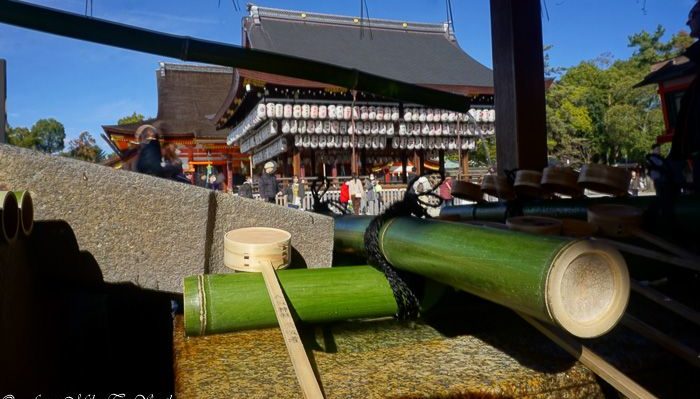
 From Miles to Smiles Stylish travel for professionals seeking luxury at affordable prices
From Miles to Smiles Stylish travel for professionals seeking luxury at affordable prices
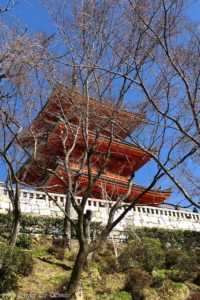
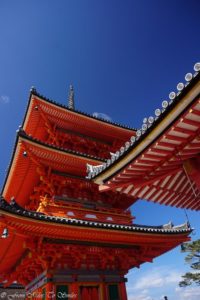
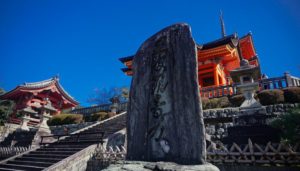



“Even in the cold grey of a Kyoto winter day…”
The weather looked pretty amazing in your photos, a stunning trip.
Are the prices you listed for the temple/ garden visits per person?
Hi Simon, Yes prices are per person and admittedly the weather in Kyoto was lovely most of the time we were there, but we definitely had a cloudy day. It really is an amazing city.